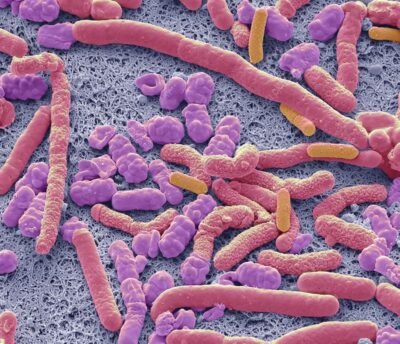The importance of probiotics

Dr. Hoger Omar Mohamed Murad
Probiotics consists of two parts, the first (Pro) means with, and the second (bios) means life. The old name or term was competitive exclusion, and the idea at the beginning was to use beneficial bacteria to compete with pathogenic bacteria for receptors on tissues and for places where pathogenic bacteria are found in the intestines.
In the intestines, there is a normal ratio of pathogenic and beneficial bacteria. For example, the pathogenic Clostridium perfringens bacteria, their number is 10 to 4 (104) per cm of the intestinal wall, but the concentration of beneficial Clostridium is 10 to 9 (109) and sometimes reaches 10 to 12. (1012).

Beneficial bacteria, when their number decreases for any reason, leads to an increase in the number of pathogenic germs such as E.coli & Colstridia because there is competition between them. When one of them increases, it is at the expense of the other. Therefore, germs (bacteria or yeasts) that are beneficial to birds must be added to increase the content of beneficial germs in the intestines. Among the most famous beneficial germs are:
Bacillus subtilis
Bacillus licheniformis
Lactobacillus acidophilus
Clostridium butricum
Enterococcus
Lactococcus
Bifidobacterium
Streptococcus
Pediococcus
Benefits and advantages of probiotics:
1-Boosting immunity: The wall of these cells contains Lipopolysaccharide & Peptidoglycan, which have a great effect on the formation of immunity in general and intestinal immunity in particular by increasing the secretion of Ig & Cyto.
2- Reducing the pH of the intestine: by secreting some organic acids such as lactic acid. This makes the medium unsuitable for the growth and reproduction of pathogenic bacteria and makes the medium more suitable for the growth of beneficial bacteria such as Lactobacillus, whose number will increase at the expense of pathogenic bacteria. Also, increasing acidity leads to the breakdown of bonds in food compounds and thus increases the digestion of nutrients in the intestine. Also, reducing the pH leads to the formation of peptide compounds whose function is to prevent the adhesion of pathogenic bacteria to their specific receptors on the intestinal wall.
3-There is a substance in the intestinal wall called. Mucin is a Glycoprotein secreted by IgG whose function is to form a protective layer for the intestines from any bacterial invasion. The most mucin-producing bacteria are Lactobacillus and these bacteria are usually considered to boost immunity and a barrier against pathogens.
4- Secretion of a substance called Bacteriocins, which are substances produced by bacteria (similar to the role of antibiotics) that have an inhibitory or lethal effect on bacteria from the same group such as Colicin. Colicin secreted by E.coli bacteria or butricin secreted by Cl.butricum, which has a lethal effect on Clostridia
5- Probiotics work as a wall or cover that covers the intestinal wall, making it difficult for pathogenic bacteria to penetrate it.
6- Probiotics adhere to receptors and intestinal cells that are important for pathogenic bacteria, such as Goblet cells, and thus bacteria do not find a way to enter the intestinal cells.
7- Secretion of H2O2, which is a substance that kills bacteria.
8- Secretion of enzymes that increase the rate of digestion of feed materials.
9- Some types of bacteria such as Bacillus improve the flavor and taste of poultry meat and reduce the percentage of fat in the abdomen and liver of birds, thus improving the percentage of purification and recovery, and reducing the percentage of cholesterol in the meat.
10- Probiotics are generally living organisms that will die after a period of 3-5 days and will therefore be absorbed by the intestines and are considered an excellent source of vitamins, especially group B, protein and amino acids.
11- There is a substance in the wall of probiotics such as yeast, Mannan, which plays a major role in controlling mycotoxins.
12- Some types of bacteria in probiotics secrete some enzymes such as Esterase, which has a major effect on mycotoxins.
13- Probiotics are a good source of minerals such as calcium and phosphorus.

In an experiment conducted by one of the universities to compare probiotics with an antibiotic growth promoter, which is Klavamycin, the use of the antibiotic had no significant effect (P.>0.5) on feed consumption and body weight gain compared to the feed containing probiotics and prebiotics, which were higher in the groups fed on feed containing probiotics, and carcass quality factors such as crude protein, crude fat, total solids (nucleic acid), acidity PH and total number of muscle fibers (T.N.F.) were also significantly higher (P<0.5) in the groups fed on feed containing probiotics. We conclude from all of this that the use of probiotics and prebiotics in feed is a good alternative to the use of antibiotics in feed.



